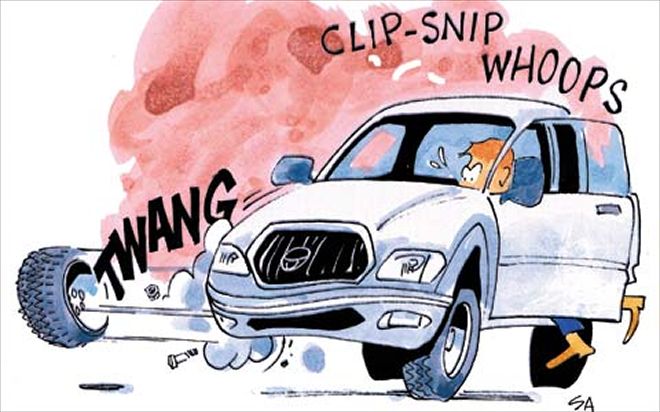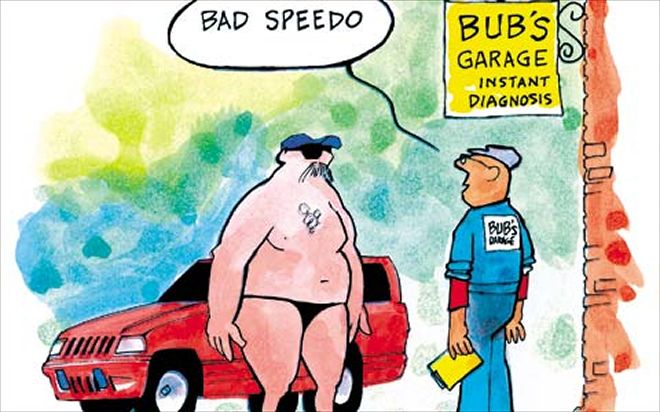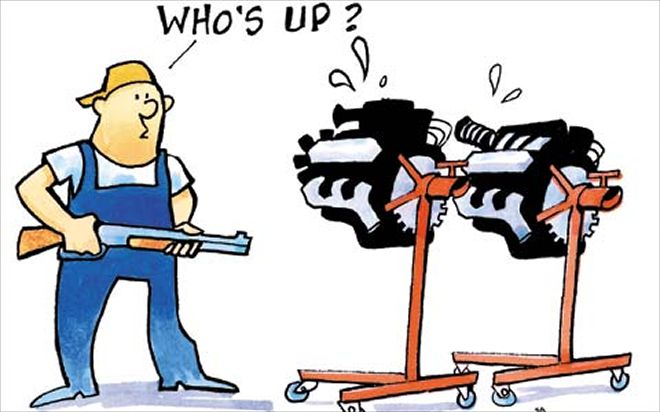
| 163 0302 Ttg01 Z
Toyota Low-Range Locking Q:I own an '02 Tacoma with the locking differential. It only locks in 4Low. The 2WD TRD Tacoma can lock its rear differential, so why can't I lock mine in 4High? I saw a modification on a Web site where you can cut a wire, and it allows you to lock it in 4High, 4Low, and 2WD. I'm wondering if this would damage the truck or if Toyota set this up as a safety precaution. It's a bad thing to drive on pavement with it locked, but it would help to have power going to the rear wheels when off-road and not being limited to only five mph.
A: I looked over the modification you're referring to, and it involves cutting and grounding a gray wire between the Engine Control Module and the 4WD Control Module. This provides a false signal of four-wheel-low transfer-case engagement to the 4WD control unit, and, in turn, will activate the locking differential regardless of 4WD operation. But I don't see how this affects the speed limitation of five mph, which is determined by vehicle speed sensor data regardless of transfer-case engagement. Toyota's full locking differential is designed for low-speed off-road operation, and common sense tells us that they activate the system only in L4 on the 4x4 models because you should be using it only in the lowest gearing available for your particular truck. This option supplies a solid mechanical lock between the two rear axles, and use under high speeds or good-traction conditions will result in damage to an axle and/or differential. I advise not messing with the system. The locking differential does a great job of slowly pulling you out of a poor-traction situation where it wouldn't make sense to be in anything but 4Low.
Trapped from the Inside Q: The power door locks on my '97 Ford Expedition have always had the option of locking automatically when you start driving away. This makes me feel more secure while the kids are in the back, and I don't have to remember to lock the doors each time we go somewhere. Now the automatic locking has stopped working, but the normal power door locks work fine. Is there a way I can reset the automatic locks before I have to see the dealer?
A: This may get complicated, but hang in there. The Autolock/Relock part of your keyless-entry system works like this: Once the ignition is in the Run or Accessory position, the transmission-gear selector has gone in and out of the Reverse position, and the brake pedal is released with all doors closed, all the doors will then lock automatically. Relock refers to the action of any door being opened and closed, after the initial lock, and then automatically Relocked with the release of the brake pedal. This entire system is controlled by the RAP (Remote Anti-theft Personality) module. The Autolock/ Relock feature is turned on at the factory, but any time battery power is lost, the RAP module will reset to the disabled position. So, if you've had a dead battery, replaced the battery, or if someone has temporarily disconnected the battery, this would explain the problem. The enable/disable procedure should be the first place to start before locating a failure within the system. Hop in and close all the doors with the ignition off, and then do the following within 30 seconds: Ignition on, press the power door-lock unlock button three times, ignition off, press the unlock button three more times. You should hear the RAP module chirp the horn indicating we're now in the enable/disable mode. Next, press the unlock button once to enable the system and then the lock button once to officially enter the command. You should then hear a short chirp followed by a longer honk indicating the Autolock/Relock feature is officially turned on. If you get only the short chirp, the system is disabled, and you must again press the unlock button followed by the lock button once. The RAP module should then chirp and honk showing the system in the enabled state. Turning the ignition off is all that's needed to end the process with the new settings. If this procedure doesn't get you going, there's a failure that will require a qualified technician to track.
Doing the Research Q: I have a '96 Chevy 1500 2WD pickup with the 5.7-liter V-8. I'm interested in finding all the recalls and service bulletins that involve this truck in case I need them in the future. Where can I locate this information?
A: It's a great idea to stay up to date on safety or emission recalls that may pertain to your vehicle. The best place to go is the National Highway Traffic Safety Administration (NHTSA). You can reach them at 888/327-4236, or better yet, check out the Web site at www.nhtsa.dot.gov. On the home page, scroll down to recalls and perform a search by entering the make, model, and year of your truck. You'll find several recalls that do apply, but remember this is basic information and not the complete service procedure. The best way to confirm that all applicable recalls have been completed on your vehicle is to go to the dealer with your Vehicle Identification Number, and let them do their own search on repairs or modifications performed. The NHTSA site is also a good source of information on crash-test results and automotive-safety related news. When dealing with Technical Service Bulletins, we suggest a search on your particular vehicle. This again will offer a brief description and not a complete service procedure. The complete TSB is published by the manufacturer and intended for use by the dealership technician.

| 163 0302 Ttg02 Z
Temperamental Speedo Q: My '98 Jeep TJ has developed an intermittent problem. The speedometer and the tach keep cutting out randomly. I can go days without it happening before it starts doing it again. Do you have any ideas on this one?
A:The '98 Jeep Wrangler (TJ) and Cherokee (XJ) both were affected by poor connection at the instrument cluster. This condition may cause erratic operation of the speedometer, tachometer, and the airbag-warning light, along with setting a fault code in the Airbag Electronic Control Module. The connection problem is actually caused by oxidation at two of the male electrical terminals on the back of the instrument cluster assembly. DaimlerChrysler has come out with Technical Service Bulletin 08-20-98A. This bulletin gives detailed instructions on removing the oxidation with the use of a scraping tool and an electrical contact cleaner. The connection is then protected by applying a specified dielectric grease. We recommend having the job done at a Jeep service department. A poor-quality repair may result in damage to the instrument cluster and/or a repeat of the original problem.
Moving Up a Size or Two Q: I recently purchased a Silverado 2500HD Crew Cab with the Duramax diesel. I wanted the dealership to install 285/75R16 tires in place of the stock 245/75R16s (too small for my tastes). The service tech told me I'd have problems with the ABS, and the "service engine soon" light would come on, as well as voiding my warranty. Hope you can help.
A: GM gas-engine pickups utilize a different system than those equipped with the Duramax diesel 6.6-liter V-8 bolted to the Allison 1000 series transmission. The Vortec engine Powertrain Control Module gives you the option of reprogramming the system to accommodate changes in tire size and/or rear-axle ratio. However, the parameters are limited to tires and gears that were originally available from the factory. Aftermarket performance reprogram kits, such as the Power Programmer III ($435) from Hypertech available for the 4.8/5.3/6.0L engines will substantially expand the tire size and gear-ratio limits, but this kit isn't available for the Duramax/Allison combination. Your 2500HD Silverado doesn't allow the limited tire-size program adjustments that can be performed at the dealer like the gas-burning Vortec-equipped trucks. But there's one aftermarket company that does offer a total performance-calibration program for GM trucks with the Duramax engine, which includes the option for significant tire-size adjustment. Pacific Performance Engineering (714/985-4825) has a sub-program available under the Duramaximizer package for about $895. Give them a call for further details. Swapping tires without the necessary adjustments may cause problems with speedometer calibration, fuel economy, ABS, and transmission operation. The installation of any aftermarket part can only affect your warranty if it's proven the modification was a direct cause of a failure.
Small-Block Firing Orders Q: I need the firing order for a 350 and a 305 Chevy engine along with the order on the distributor cap. I'm trying to get a friend's van on the road, and I'm sure the firing order is causing the problem.

| 163 0302 Ttg03 Z
A: We're talking about small-block Chevy engines, and they both have the same firing order. The 350 and 305 CIDs are basically twins with different bore and stroke values. The firing order is 1-8-4-3-6-5-7-2. This is how each cylinder is fired to keep the crankshaft turning smoothly and is also the order the ignition wires are attached at the distributor cap going in a clockwise direction. Where cylinder #1 wire is located can vary depending on model and year. However, a common location is at about 11 o'clock (standing behind the engine). If the distributor is installed correctly, the rotor will point to this spot when the engine is brought up to Top Dead Center on the compression stroke for cylinder #1. If you're unfamiliar with cylinder locations, they're 1-3-5-7 front to rear on the left bank and 2-4-6-8 front to rear on the right. Right and left are always determined while sitting in the driver's seat.
Chevy Exhaust Stopping Q: I have a Duramax diesel and want to put an exhaust brake on it. I keep hearing people say it'll hurt my motor because of the back-pressure. Is this true?
A: Exhaust brakes are a common aftermarket add-on in mostly heavy-duty applications, but they're also available for General Motors' pickups with the Duramax 6600 V-8 diesel. There are drawbacks to a diesel engine while downshifting the transmission on a steep downgrade in order to provide engine braking. As opposed to a gas engine with a throttle plate that meters the amount of air entering the engine, the diesel has a wide-open intake that limits the production of backpressure needed to slow the truck and preserve its conventional brakes. The exhaust brake is a pivoting plate that blocks the exhaust side of the engine to increase backpressure on deceleration and therefore aid in engine braking. GM Powertrain Product Communications says the Isuzu-built Duramax was designed for use with an exhaust-brake assembly. However, GM doesn't produce one or recommend a particular exhaust-brake manufacturer. There shouldn't be a risk of engine damage unless resulting from the failure of the exhaust brake itself. Companies that produce exhaust-brake systems for the Duramax are Pacbrake Engine Brakes and BD Engine Brake Inc. Jacobs Vehicle Systems, a well-known manufacturer of exhaust brakes, doesn't produce one for the Duramax because its policy requires direct approval from the engine company. While speaking with a representative, we also learned something helpful for Ford PowerStroke diesel-engine owners. Ford has requested they do not produce an exhaust-brake system for the PowerStroke due to the possibility of damage to engines equipped with hydraulic valve lifters. The high backpressure condition tend to cause valve float that may result in valve-to-piston contact.
Dodge Automatic Cleaning Q: I purchased a '95 Dodge Ram 1500 5.2-liter with 62,000 miles, and I don't know if the four-speed automatic transmission has been serviced previously. A friend advised that, if I change the fluid now, and if it hasn't been serviced in the past, I might do more harm than good by dislodging sediment and debris. I am fairly experienced in automotive matters, and I have heard this before from other people. However, it just seems like an old wives' tale to me. I would appreciate your opinion. Incidentally, I'm not having transmission trouble. I just want to service it properly.

| 163 0302 Ttg04 Z
A: I've heard the same stories, but have yet to see it proven. If you do a careful job of replacing the filter, while cleaning out the pan and removing the gasket thoroughly, it shouldn't be an issue. Also, 62,000 miles on your Ram isn't an astronomical number. If it were double that, I might be more concerned. Some folks don't realize that by simply dropping the transmission pan, you're not replacing anywhere near all the fluid in the unit. A large quantity is held within the torque converter, various pistons, servos, and cavities. Most fully equipped shops use a system that splices into the transmission-cooler lines and pumps in the new fluid while it pumps out the old. This does a much better job of replacing the entire capacity. I suggest replacing the filter and then taking it in for a complete flush. We won't tell anyone you had your fingers crossed.
Light Towing Advice Q: I have a 2000 Honda Odyssey with the towing package (transmission cooler, hitch, receiver, and wiring). I tow a tent trailer that's within the weight rating for the hitch and van. When the van is loaded with cargo and the trailer is hooked up, the rear suspension lags too much. Without going for air shocks, as I don't want to change the ride too much, would aftermarket shocks or other suspension add-ons work better?
A:We've been getting a lot of similar questions regarding the sag in the rear while towing on some light-duty pickups, SUVs, and minivans. As always, you want to double check on the total trailer weight, payload, and combined weight ratings of your particular vehicle. If you're close or above, that's the problem. You need to lighten the load or invest in a heavier-duty truck. It's a good idea to take a look at how your Odyssey sits with the trailer off and the full cargo load onboard. Is it the trailer causing the sag or the heavy load in the back of the van? If it's sagging without the trailer, you may want to install air-adjustable shocks. They're relatively inexpensive and won't affect the normal ride if used properly. Simply add air pressure when needed to bring the rear ride height back to normal while hauling a full cargo load. Then release the pressure after the cargo is removed to eliminate any change from your original factory ride. Any rear-spring replacement or modification will have a permanent effect, and standard shock absorbers have no effect on a vehicle's ride height. Now, as in many cases, if the sag in the rear is caused by the tongue weight of the trailer load, there's another route to follow. First, be sure that the trailer's tongue weight is correct. It should be approximately 10-15 percent of the total trailer weight. If not, the trailer content must be redistributed and/or other trailer modifications performed. Once you've determined you're safely within all the vehicle specifications, it's time to install a weight-distributing hitch assembly (see previous Q&A). If you take a look at your owner's manual in the towing section, you'll see that Honda recommends the use of a weight-distributing hitch when the total trailer weight exceeds 1850 lb, along with the use of a sway-control device above 2000 lb. Manufacturers of these types of towing accessories include Draw-Tite and Hidden Hitch.
How To Reach AlexIf you have a technical question regarding your pickup, SUV, or van, feel free to contact Alex, a master technician with the National Institute for Automotive Service Excellence. Send a letter to him in care of Truck Trend Garage, 831 S. Douglas Street, El Segundo, CA 90245, or e-mail us at trucktrend@sourceinterlink.com. Please include the VIN with your question. Due to the volume of questions received every month, we cannot guarantee that everyone's question will be personally answered or will appear in the magazine.
Can't wait for help with a problem you're having with your Truck or SUV? Ask the expert we trust here at Truck Trend Garage--visit Alex Steele at www.RealWorldAutomotive.com.
 | 163 0302 Ttg01 Z
Toyota Low-Range Locking
| 163 0302 Ttg01 Z
Toyota Low-Range Locking | 163 0302 Ttg02 Z
Temperamental Speedo
| 163 0302 Ttg02 Z
Temperamental Speedo | 163 0302 Ttg03 Z
A: We're talking about small-block Chevy engines, and they both have the same firing order. The 350 and 305 CIDs are basically twins with different bore and stroke values. The firing order is 1-8-4-3-6-5-7-2. This is how each cylinder is fired to keep the crankshaft turning smoothly and is also the order the ignition wires are attached at the distributor cap going in a clockwise direction. Where cylinder #1 wire is located can vary depending on model and year. However, a common location is at about 11 o'clock (standing behind the engine). If the distributor is installed correctly, the rotor will point to this spot when the engine is brought up to Top Dead Center on the compression stroke for cylinder #1. If you're unfamiliar with cylinder locations, they're 1-3-5-7 front to rear on the left bank and 2-4-6-8 front to rear on the right. Right and left are always determined while sitting in the driver's seat.
Chevy Exhaust Stopping
| 163 0302 Ttg03 Z
A: We're talking about small-block Chevy engines, and they both have the same firing order. The 350 and 305 CIDs are basically twins with different bore and stroke values. The firing order is 1-8-4-3-6-5-7-2. This is how each cylinder is fired to keep the crankshaft turning smoothly and is also the order the ignition wires are attached at the distributor cap going in a clockwise direction. Where cylinder #1 wire is located can vary depending on model and year. However, a common location is at about 11 o'clock (standing behind the engine). If the distributor is installed correctly, the rotor will point to this spot when the engine is brought up to Top Dead Center on the compression stroke for cylinder #1. If you're unfamiliar with cylinder locations, they're 1-3-5-7 front to rear on the left bank and 2-4-6-8 front to rear on the right. Right and left are always determined while sitting in the driver's seat.
Chevy Exhaust Stopping | 163 0302 Ttg04 Z
A: I've heard the same stories, but have yet to see it proven. If you do a careful job of replacing the filter, while cleaning out the pan and removing the gasket thoroughly, it shouldn't be an issue. Also, 62,000 miles on your Ram isn't an astronomical number. If it were double that, I might be more concerned. Some folks don't realize that by simply dropping the transmission pan, you're not replacing anywhere near all the fluid in the unit. A large quantity is held within the torque converter, various pistons, servos, and cavities. Most fully equipped shops use a system that splices into the transmission-cooler lines and pumps in the new fluid while it pumps out the old. This does a much better job of replacing the entire capacity. I suggest replacing the filter and then taking it in for a complete flush. We won't tell anyone you had your fingers crossed.
Light Towing Advice
| 163 0302 Ttg04 Z
A: I've heard the same stories, but have yet to see it proven. If you do a careful job of replacing the filter, while cleaning out the pan and removing the gasket thoroughly, it shouldn't be an issue. Also, 62,000 miles on your Ram isn't an astronomical number. If it were double that, I might be more concerned. Some folks don't realize that by simply dropping the transmission pan, you're not replacing anywhere near all the fluid in the unit. A large quantity is held within the torque converter, various pistons, servos, and cavities. Most fully equipped shops use a system that splices into the transmission-cooler lines and pumps in the new fluid while it pumps out the old. This does a much better job of replacing the entire capacity. I suggest replacing the filter and then taking it in for a complete flush. We won't tell anyone you had your fingers crossed.
Light Towing Advice